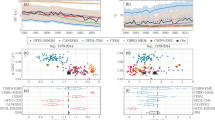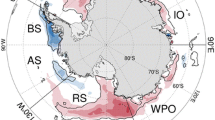Abstract
Arctic marginal ice zone (MIZ) widths in the Atlantic sector were measured during the months of maximum sea ice extent (February–April) for years 1979–2010 using a novel method based on objective curves through idealized sea ice concentration fields that satisfied Laplace’s equation. Over the record, the Labrador Sea MIZ (MIZL) had an average width of 122 km and narrowed by 28 % while moving 254 km poleward, the Greenland Sea MIZ (MIZG) had an average width of 98 km and narrowed by 43 % while moving 158 km west toward the Greenland coast, and the Barents Sea MIZ (MIZB) had an average width of 136 km and moved 259 km east toward the Eurasian coast without a trend in width. Trends in MIZ position and width were consistent with a warming Arctic and decreasing sea ice concentrations over the record. Beyond the trends, NAO-like atmospheric patterns influenced interannual variability in MIZ position and width: MIZL widened and moved southeast under anomalously strong northerly flow conducive to advection of sea ice into the Labrador Sea, MIZG widened and moved northeast under anomalously weak northerly flow conducive to diminishing the westward component of sea ice drift, and MIZB widened and moved poleward at the expense of pack ice under anomalously strong southwesterly flow conducive to enhancing oceanic heat flux into the Barents Sea. In addition, meridional flow anomalies associated with the NAO per se moved MIZB east and west by modulating sea ice concentration over the Barents Sea.










Similar content being viewed by others
References
Arrigo KR, Thomas DN (2004) Large scale importance of sea ice biology in the Southern Ocean. Antarct Sci 16:471–486
Bitz CM, Holland MM, Hunke EC, Moritz RE (2005) Maintenance of the sea–ice edge. J Clim 18(15):2903–2921
Cavalieri D, Parkinson C, Gloersen P, Zwally HJ (1996) Sea ice concentrations from Nimbus-7 SMMR and DMSP SSM/I passive microwave data, 1979–2010. National Snow and Ice Data Center, Boulder. Digital media
Cohen J, Barlow M (2005) The NAO, the AO, and global warming: how closely related? J Clim 18(21):4498–4513. doi:10.1175/JCLI3530.1
Comiso JC (2006) Abrupt decline in Arctic winter sea ice cover. Geophys Res Lett 33. doi:10.1029/2006GL027341
Deser C, Teng H (2008) Evolution of Arctic sea ice concentration trends and the role of atmospheric circulation forcing, 1979–2007. Geophys Res Lett 35. doi:10.1029/2007GL032023
Deser C, Walsh JE, Timlin MS (2000) Arctic sea ice variability in the context of recent atmospheric circulation trends. J Clim 13:617–633
Deser C, Magnusdottir G, Saravanan R, Phillips AS (2004) The effects of North Atlantic SST and sea–ice anomalies on the winter circulation in CCM3. Part II: direct and indirect components of the response. J Clim 17:877–889
Deser C, Tomas RA, Peng S (2007) The transient atmospheric circulation response to North Atlantic SST and sea ice anomalies. J Clim 20:4751–4767
Duchon J (1976) Splines minimizing rotation-invariant semi-norms in Sobolev spaces. In: Constructive theory of functions of several variables. Springer
Dumont D, Kohout A, Bertino L (2011) A wave-based model for the marginal ice zone including a floe breaking parameterization. J Geophys Res 116. doi:10.1029/2010JC006682
Dunbar MJ (1986) Arctic marine ecosystems. Oceanus 29:36–40
Efron B (1979) Bootstrap methods: another look at the jackknife. Ann Stat 7:1–26
Eisenman I (2010) Geographic muting of changes in the Arctic sea ice cover. Geophys Res Lett 37. doi:10.1029/2010GL043741
Fang Z, Wallace JM (1994) Arctic sea ice variability on a timescale of weeks and its relation to atmospheric forcing. J Clim 7(12):1897–1914
Francis JA, Hunter E (2007) Drivers of declining sea ice in the Arctic winter: a tale of two seas. Geophys Res Lett 34. doi:10.1029/2007GL030995
Furevik T (2001) Annual and interannual variability of Atlantic Water temperatures in the Norwegian and Barents Seas: 1980–1996. Deep Sea Res I Oceanogr Res Pap 48(2):383–404. doi:10.1016/S0967-0637(00)00050-9
Germe A, Houssais M-N, Herbaut C, Cassou C (2011) Greenland Sea sea ice variability over 1979–2007 and its link to the surface atmosphere. J Geophys Res 116. doi:10.1029/2011JC006960
Gillett NP, Stott PA (2009) Attribution of anthropogenic influence on seasonal sea level pressure. Geophys Res Lett 36. doi:10.1029/2009GL041269
Hilmer M, Jung T (2000) Evidence for a recent change in the link between the North Atlantic Oscillation and Arctic Sea ice export. Geophys Res Lett 27(7):989–992
Holland MM, Bitz CM, Eby M, Weaver AJ (2001) The role of ice-ocean interactions in the variability of the North Atlantic thermohaline circulations. J Clim 14(5):656–675
Hurrell J (1995) NAO Index data provided by the climate analysis section: “NAO PC Based (Monthly)”. http://www.cgd.ucar.edu. Accessed Jan 2012
Hurrell JW, Kushnir Y, Ottersen G, Visbeck M (eds) (2003) The North Atlantic Oscillation: climate significance and environmental impact. Am Geophys. Union Geophysical Monograph Series (134)
Ingvaldsen RB, Asplin L, Loeng H (2004) Velocity field of the western entrance to the Barents Sea. J Geophys Res 109. doi:10.1029/2003JC001811
Joly S, Senneville S, Caya D, Saucier F (2011) Sensitivity of Hudson Bay Sea ice and ocean climate to atmospheric temperature forcing. Clim Dyn 36(9):1835–1849
Jones SE, Buchbinder BR, Aharon I (2000) Three-dimensional mapping of cortical thickness using Laplace’s equation. Hum Brain Mapp 11:12–32
Jung T, Hilmer M (2001) The link between the North Atlantic Oscillation and Arctic sea ice export through Fram Strait. J Clim 14(19):3932–3943
Kalnay E et al (1996) The NCEP/NCAR 40-year reanalysis project. Bull Am Meteorol Soc 77:437–471
Koberle C, Gerdes R (2003) Mechanisms determining the variability of Arctic sea ice conditions and export. J Clim 16:2843–2858
Lindsay RW, Zhang J (2005) The thinning of Arctic sea ice, 1998–2003: have we passed a tipping point? J Clim 18:4879–4894
Liu J, Martinson DG, Yuan X, Rind D (2002) Evaluating Antarctic sea ice variability and its teleconnections in global climate models. Int J Climatol 22(8):885–900
Lubin D, Massom R (2006) Sea ice. In: Polar remote sensing volume i: atmosphere and oceans. Springer, Berlin, pp 309–728
Magnusdottir G, Deser C, Saravanan R (2004) The effects of North Atlantic SST and sea ice anomalies on the winter circulation in CCM3. Part I: main features and storm track characteristics of the response. J Clim 17:857–876
Meier W, Notz D (2010) A note on the accuracy and reliability of satellite-derived passive microwave estimates of sea-ice extent, CliC Arctic Sea Ice Working Group Consensus Document. In: The 2nd meeting of the CliC Arctic Sea Ice Working Group (ASWG2)
NIC (2011) Products on Demand: Marginal Ice Zone. Digital media. Accessed Dec 2011
Parkinson CL, Cavalieri DJ, Gloersen P, Zwally HJ, Comiso JC (1999) Arctic sea ice extents, areas, and trends, 1978–1996. J Geophys Res 104(C9):20837–20856
Partington K, Flynn T, Lamb D, Bertoia C, Dedrick K (2003) Late twentieth century Northern Hemisphere sea-ice record from US National Ice Center ice charts. J Geophys Res 108. doi:10.1029/2002JC001623
Perrette M, Yool A, Quartly GD, Popova EE (2010) Near-ubiquity of ice-edge blooms in the Arctic. Biogeosci Discuss 7(6):8123–8142. doi:10.5194/bgd-7-8123-2010
Rigor IG, Wallace JM (2004) Variations in the age of Arctic sea-ice and summer sea-ice extent. Geophys Res Lett 31. doi:10.1029/2004GL019492
Rigor IG, Wallace JM, Colony RL (2002) Response of sea ice to the Arctic Oscillation. J Clim 15:2648–2663
Rogers JC, Van Loon H (1979) The Seesaw in Winter Temperatures between Greenland and Northern Europe. Part II: some oceanic and atmospheric effects in middle and high latitudes. Mon Weather Rev 107(5):509–519
Saucier FJ, Roy F, Gilbert D, Pellerin P, Ritchie H (2003) Modeling the formation and circulation processes of water masses and sea ice in the Gulf of St. Lawrence, Canada. J Geophys Res 108. doi:10.1029/2000JC000686
Schinzinger R, Laura P (2003) Conformal mapping: methods and applications. Dover, New York
Schlichtholz P (2011) Influence of oceanic heat variability on sea ice anomalies in the Nordic Seas. Geophys Res Lett 38. doi:10.1029/2010GL045894
Shuchman RA, Josberger EG, Russel CA, Fischer KW, Johannessen OM, Johannessen J, Gloersen P (1998) Greenland Sea Odden sea ice feature: Intra-annual and interannual variability. J Geophys Res 103(C6):12709–12724
Skagseth O, Furevik T, Ingvaldsen R, Loeng H, Mork K, Orvik K, Ozhigin V (2008) Defining the role of the Northern Seas in climate, chap Volume and heat transports to the Arctic via the Norwegian and Barents Seas. Springer
Smedsrud LH, Sorteberg A, Kloster K (2008) Recent and future changes of the Arctic sea-ice cover. Geophys Res Lett 35. doi:10.1029/2008GL034813
Sorteberg A, Kvingedal B (2006) Atmospheric forcing of the Barents Sea winter ice extent. J Clim 19:4772–4784
Stroeve J, Holland MM, Meier W, Scambos T, Serreze M (2007) Arctic sea ice decline: faster than forecast. Geophys Res Lett 34. doi:10.1029/2007GL029703
Strong C, Magnusdottir G (2010) The role of tropospheric Rossby wave breaking in shaping the equilibrium atmospheric circulation response to North Atlantic boundary forcing. J Clim 23:1269–1276
Vinje T (2001) Anomalies and trends in sea-ice extent and atmospheric circulation in the Nordic Seas during the period 1864–1998. J Clim 14:3503–3517
Wadhams P (2000) Ice in the Ocean. Gordon and Breach Science Publishers, Sydney
Wadhams P, Comiso JC, Prussen E, Wells S, Brandon M, Aldworth E, Viehoff T, Allegrino R, Crane DR (1996) The development of the Odden ice tongue in the Greenland Sea during winter 1993 from remote sensing and field observations. J Geophys Res 101(C8):18213–18235
Walsh JE, Johnson CM (1979) An analysis of Arctic Sea ice fluctuations. J Phys Oceanogr 9:580–591
Wang J, Mysak LA, Ingram RG (1994) Interannual variability of seace cover in Hudson bay, Baffin bay and the Labrador sea. Atmos Ocean 32(2):421–447
WMO (1985) World Meteorological Organization sea-ice nomenclature, terminology, codes and illustrated glossary, WMO/DMM/BMO 259-TP-145. Secretariat of the World Meteorological Organization
Wu Q, Zhang X (2010) Observed forcing-feedback processes between Northern Hemisphere atmospheric circulation and Arctic sea ice coverage. J Geophys Res 115. doi:10.1029/2009JD013574
Acknowledgments
Comments from Dany Dumont and anonymous reviewers helped to improve the manuscript. This research was supported by National Science Foundation grant ARC-1022485.
Author information
Authors and Affiliations
Corresponding author
Rights and permissions
About this article
Cite this article
Strong, C. Atmospheric influence on Arctic marginal ice zone position and width in the Atlantic sector, February–April 1979–2010. Clim Dyn 39, 3091–3102 (2012). https://doi.org/10.1007/s00382-012-1356-6
Received:
Accepted:
Published:
Issue Date:
DOI: https://doi.org/10.1007/s00382-012-1356-6




